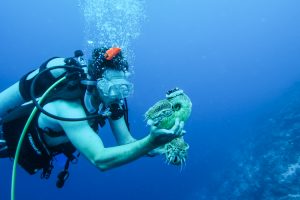Central Campus Teacher’s Team Makes Exciting Underwater Discovery

Dr. Greg Barord releases two Allonautilus scrobiculatus (fuzzy Nautilus) with ultrasonic transmitters attached to the dorsal sides of their shells.
Though Dr. Greg Barord teaches about as far from an ocean as one can and still be part of a top-notch high school marine biology program, his heart has always been in the sea. And when the Central Campus teacher travels for research, as he did this summer, he’s all in.
“We lived aboard a canoe for two weeks,” Barord said. “It was our office, kitchen, bedroom and bathroom. There was another bathroom/outhouse along a narrow walkway out over the ocean. We had no running water at any time. We showered with collected rainwater, using a small pitcher to rinse off.”
Though the living conditions made the restrooms at Central Campus look like 5-star accommodations, Dr. Barord’s sacrifice paid off with a headline-grabbing discovery.
“Our research team traveled to Papua New Guinea to study nautiluses and “rediscovered” a nautilus thought to be possibly extinct,” Barord said. “It was beyond amazing!”
Working 100-500m deep, Barord and his team captured images and the first video of the rarest nautilus, Allonautilus, also known as the fuzzy nautilus, in the wild. It was last seen more than 30 years ago.
Another first, the research team attached ultrasonic transmitters to the nautiluses’ shells and tracked them, collecting data about their movements and living conditions.
“It was an experience I will never forget,” Barord said.
He credits his team, and the native tribe on the island.
“We worked closely with dozens of members of the Mbunai tribe, 24 hours a day,” he said, “and we could not have collected such great data and results without their help.”
The research was sponsored by National Geographic, the United States National Science Foundation, The Nature Conservancy, the Minnesota Zoo, the American Museum of Natural History and the Save the Nautiluses Foundation.
Follow Dr. Greg Barord’s blog at centralcampus.dmschools.org. Read the first installment here.




